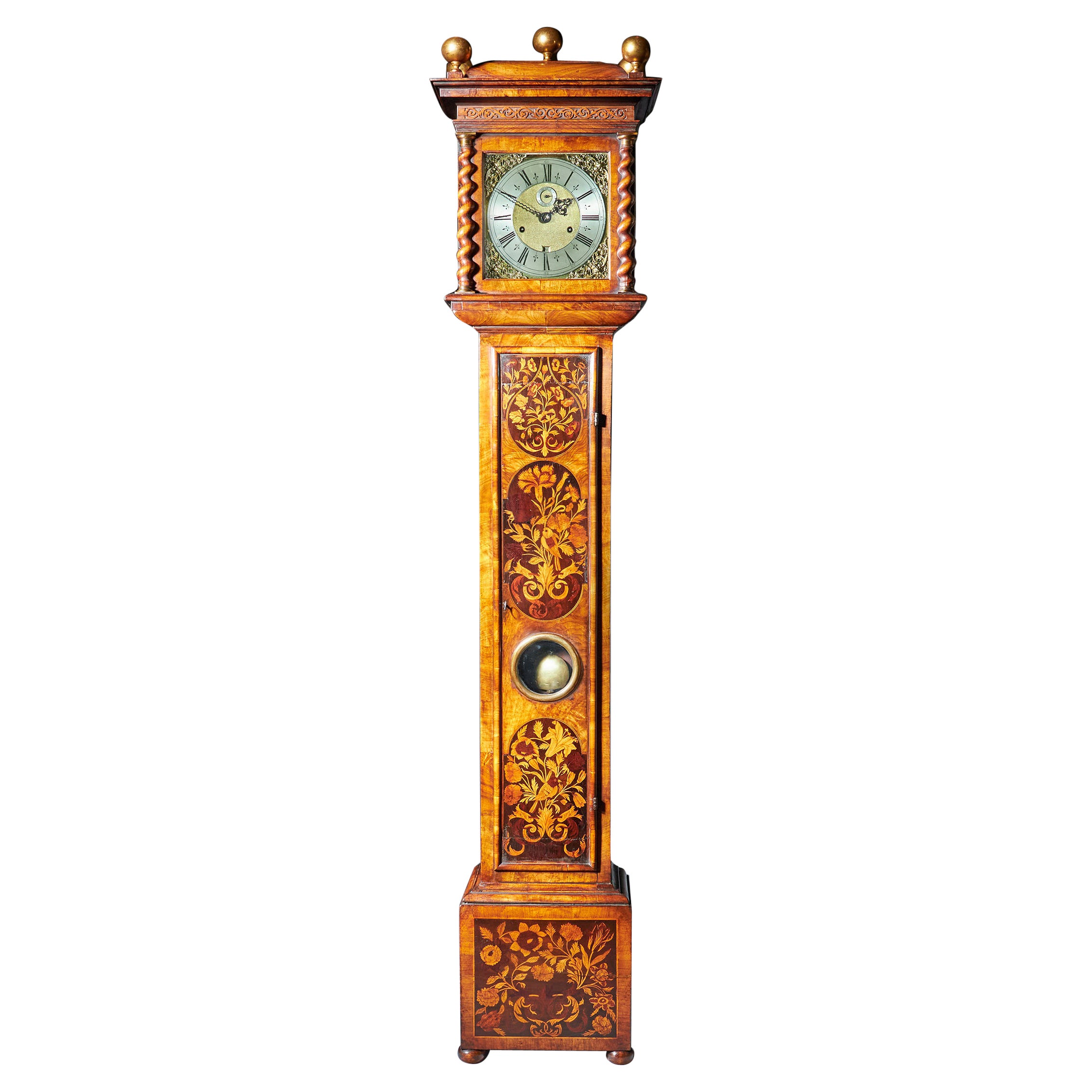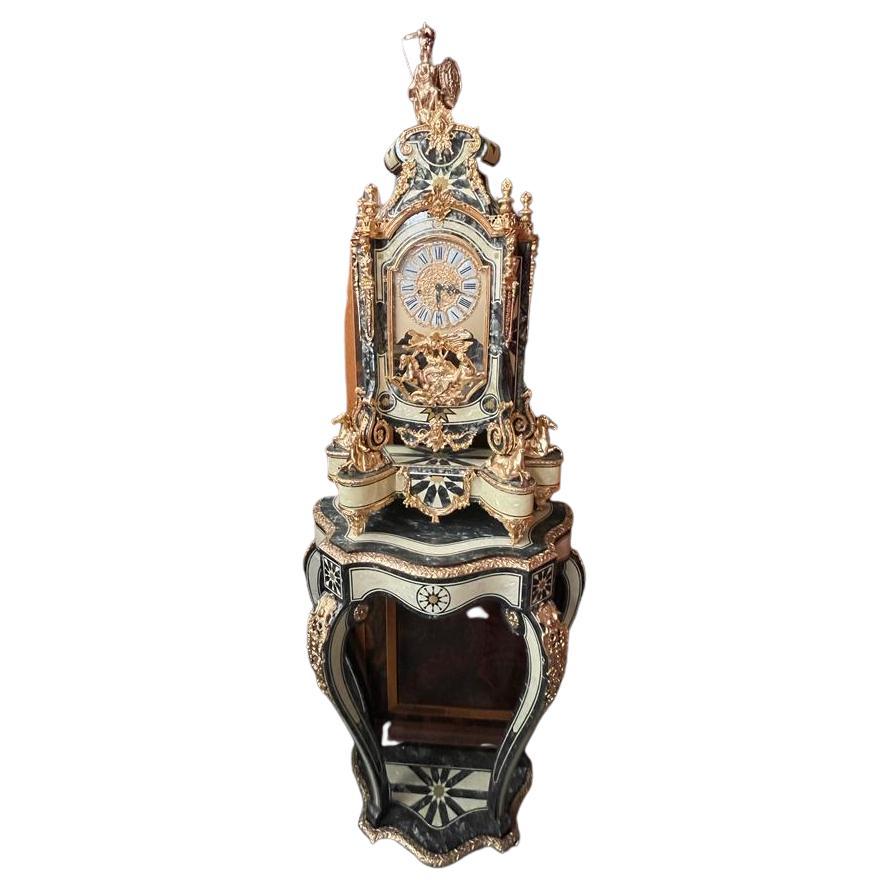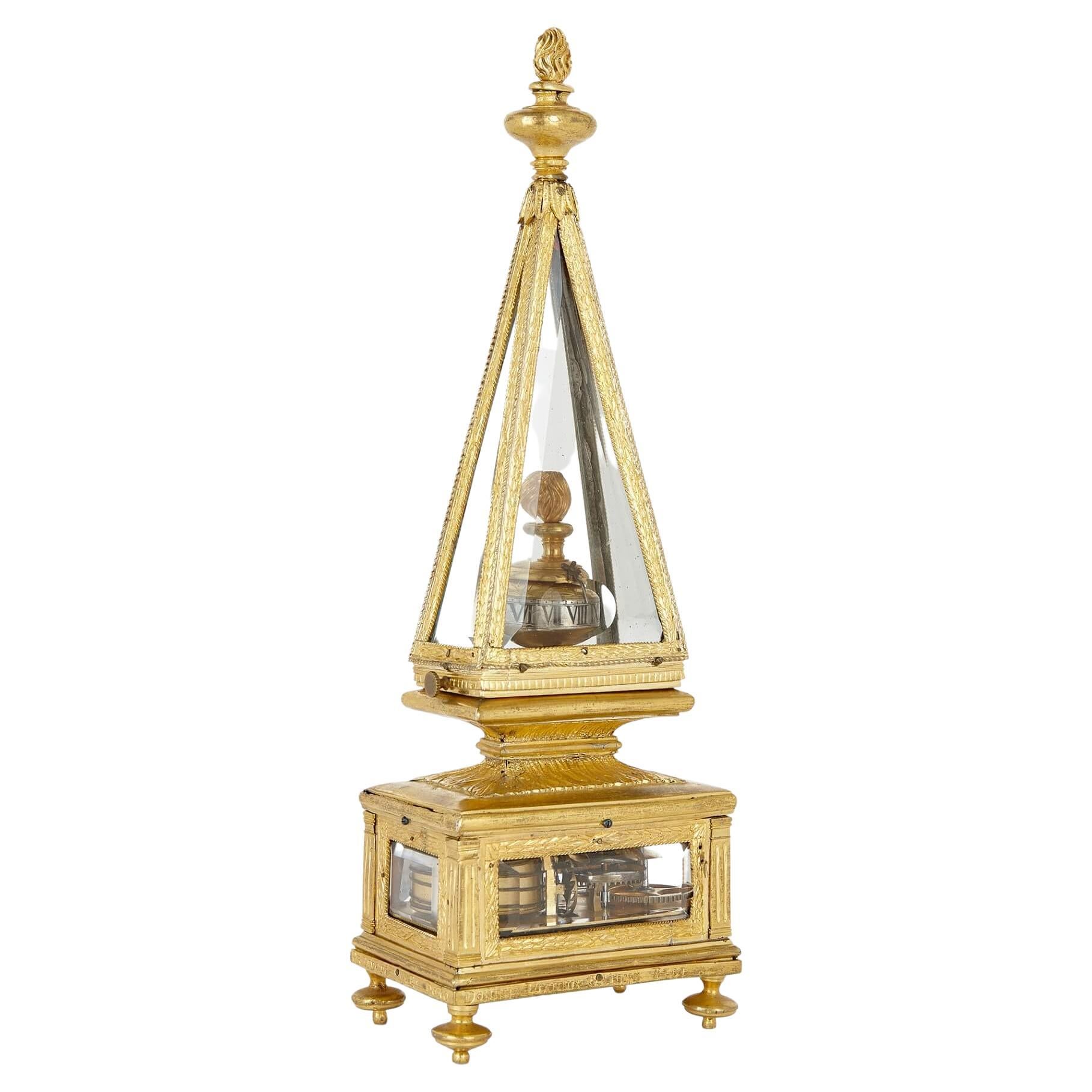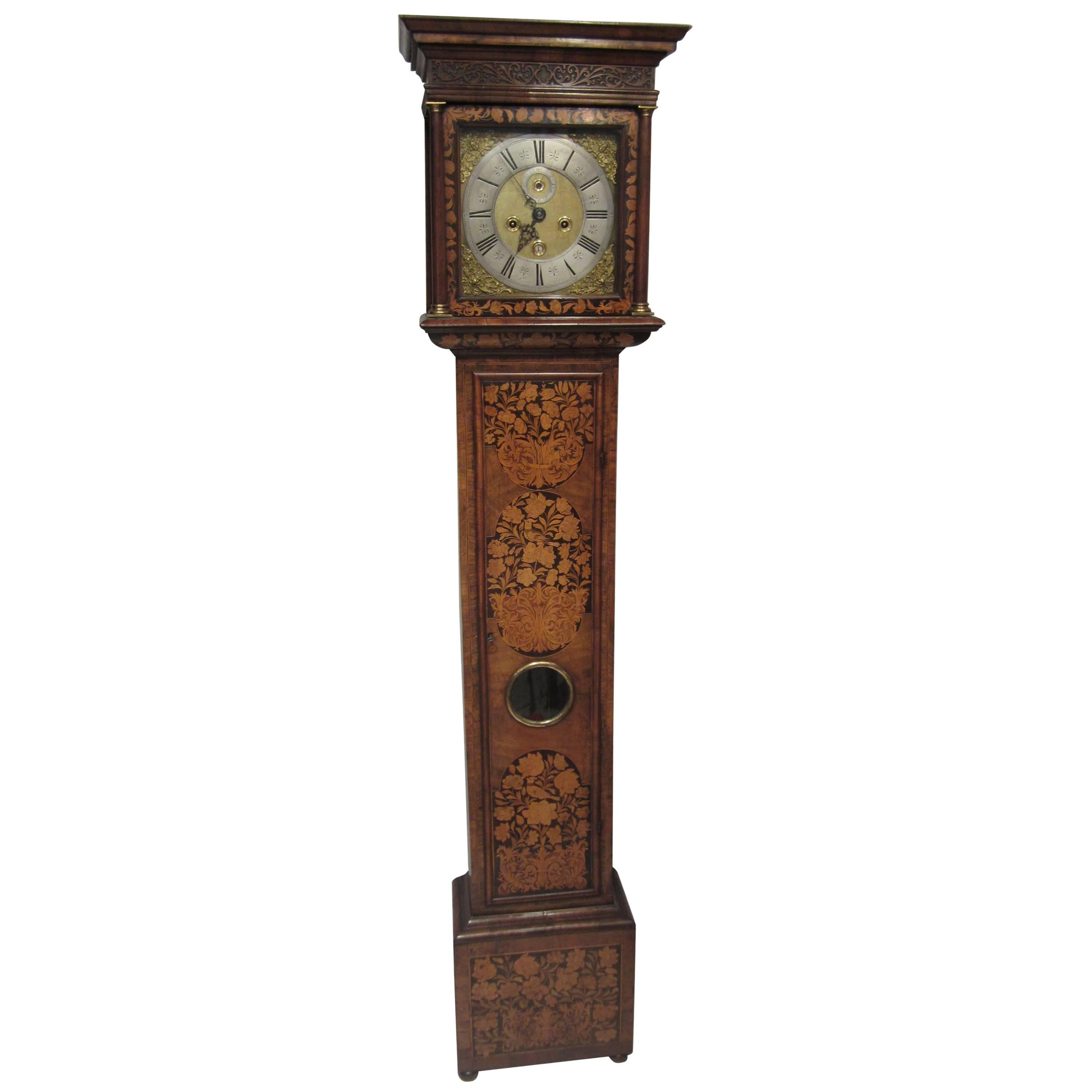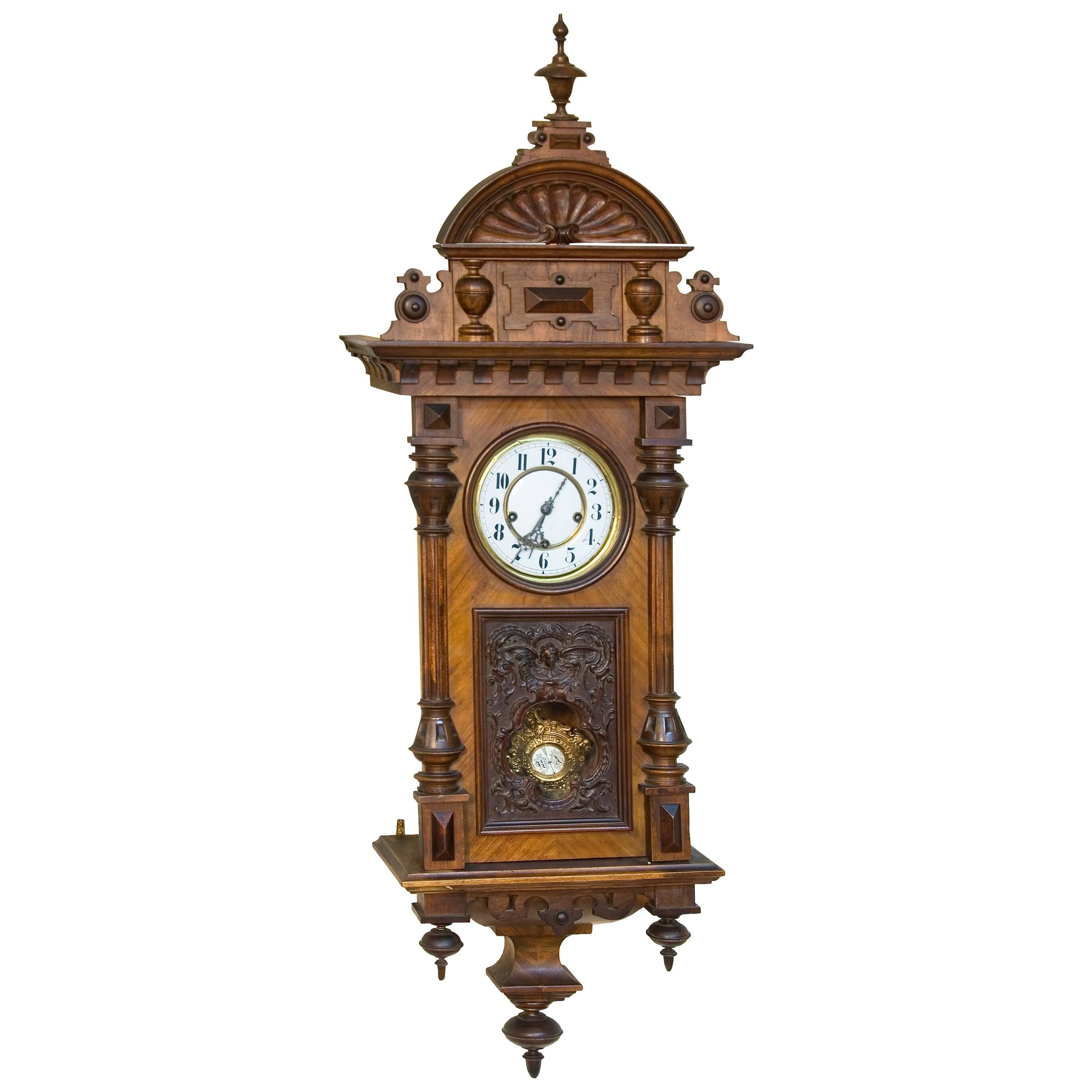Items Similar to A Rare and Important Charles II 17th Century Table Clock by Henry Jones
Want more images or videos?
Request additional images or videos from the seller
1 of 12
A Rare and Important Charles II 17th Century Table Clock by Henry Jones
About the Item
The Rare and Important 17th Century Spring Driven Table Clock by the Celebrated Maker, Henry Jones.
Provenance dating back to 1745. Owned by Captain Alexander Raitt
A very rare and unusual Charles II English eight-day spring-driven table clock signed on the backplate, Henry Jones in the Temple, dating back to the period c.1675-80.
The elegantly proportioned ebony-veneered oak basket top case, whose austerity goes straight back to East-style models, has extremely shallow mouldings and large rectangular viewing windows to the sides so that the movement is almost entirely visible. The case rests on four brass bun feet.
The fine square brass dial with matted centre and just winding holes has an applied silvered chapter ring and winged cherub-head spandrels in the corners. The chapter ring is engraved with a narrow outer minute ring within which are Arabic five-minute numerals and two different types of 7½-minute markers, a central ring with Roman hours I-XII and fleur-de-lys half-hour markers and an inner ring divided into quarter hours. The time is indicated by an elegant pair of finely pierced period blued steel hands. Above the XII is a strike/silent aperture with original switch.
The striking eight-day twin fusee brass movement, with six latched pillars, early fusees with open click work and verge escapement with a short knife-suspended pendulum. The striking, which is regulated by an internal rack, indicates the hours fully on a bell. The backplate shows the pre-setting ratchet wheels with typical clicks and a fine U-shaped click spring. It is profusely engraved in period style around a typical signature cartouche with the maker’s name: Henry Jones in the Temple. The movement has an unusual bar operated pull-quarter repeat on two bells differing in pitch, one for the quarters and the other the hour bell.
The maker
Henry Jones was born at Boulder near Southampton in 1634 and was apprenticed to the famous maker Edward East in 1654 through the Clockmakers’ Company. He was made free in 1663 but remained working for East until 1672, when he set up in the Inner Temple. Later he was recorded in the Inner Temple Lane. He was a prolific maker, his work being highly thought of. Apart from spring, lantern and longcase clocks, he also made watches.
Literature:
B. Loomes, The Clockmakers of Great Britain 1286-1700, Ashbourne, 2014, pp.430-31.
B. Loomes, Watchmakers and clockmakers of the World, London, 2006, p.429.
Provenance
This clock is known as the Alexander Raitt clock. It was shipped from Scotland to America by Captain Alexander Raitt in 1745, sailing his own ship. Captain Raitt settled in Kittery in the province of Maine of the Massachusetts Bay Colony. On October 2, 1747, he married Miriam Frost (1722-1807), widow of Eliot Frost, a daughter of the Honourable John Frost of New Castle, New Hampshire.
The house where the Raitts lived is still in a good state of preservation in Kittery, now Eliot. It was built by Eliot Frost, Miriam’s first husband in 1740.
The clock, descending from father to son since it was brought over from Scotland and has been in the Raitt family until it was acquired by Miss Elizabeth Mehitable Bartlett of Eliot who presented it to her brother Ralph Sylvester Bartlett in 1939. It was still in his possession in 1941. It later went to his cousin John William Pepperrel Frost, who was the last owner, before we acquired the clock.
- Creator:Henry Jones (Clockmaker)
- Dimensions:Height: 12.6 in (32 cm)Width: 9.06 in (23 cm)Depth: 5.91 in (15 cm)
- Style:Charles II (Of the Period)
- Materials and Techniques:
- Place of Origin:
- Period:
- Date of Manufacture:1675-1690
- Condition:Repaired. Replacements made. Wear consistent with age and use. The repeat work was partly restored to the original pattern. Several missing parts were made in the correct style.
- Seller Location:Oxfordshire, GB
- Reference Number:1stDibs: LU4936237642372
About the Seller
5.0
Recognized Seller
These prestigious sellers are industry leaders and represent the highest echelon for item quality and design.
1stDibs seller since 2019
20 sales on 1stDibs
Associations
LAPADA - The Association of Arts & Antiques Dealers
- ShippingRetrieving quote...Ships From: Faringdon , United Kingdom
- Return PolicyA return for this item may be initiated within 14 days of delivery.
More From This SellerView All
- 17th Century Charles II Month Going Marquetry Longcase Clock by John WiseLocated in Oxfordshire, United KingdomA superb Charles II month duration floral marquetry longcase clock by the well-known maker John Wise, c. 1680-85. Measure: 10". The case is of the highest quality and decorated throughout in very attractive floral marquetry depicting spring flowers and birds showing a high level of sophistication with a glazed circular lenticle to the door. Similarly, the rising hood is decorated with blind frets around the top and surmounted by a shallow caddy decorated by five gilt wooden ball finials. It is flanked by prominent gilt brass-capped solid barley twist columns, with blind fretted panels to the sides. The month-going nicely finned and knopped five pillar movement has reversed going and striking trains, the striking train (on the right) being regulated by a small outside countwheel. The going train has anchor escapement and a seconds pendulum. The movement is fronted by a 10-inch brass dial with an unusual narrow silvered chapter ring, seconds ring and date aperture. It has elaborate cherub-head spandrels in the corners and is signed along the bottom John Wise Londini Fecit. The middle is finely matted, whilst the time is indicated by a fine pair of blued-steel hands, the hour hand richly pierced. The maker John Wise was born in Banbury shortly before 17 March 1624, the date of his baptism. He was the son of John and Ann Wise and a cousin of Joseph Knibb...Category
Antique 17th Century British Charles II Grandfather Clocks and Longcase ...
MaterialsBrass, Steel
- Important 17th Century Charles II Silk Needlework / Stumpwork MirrorLocated in Oxfordshire, United KingdomAn important Charles II silk embroidered looking glass from the third quarter of the 17th century (1662-1675) England. The impressive and rare looking...Category
Antique 17th Century English Charles II Wall Mirrors
MaterialsSilk, Walnut
- Rare 17th Century William and Mary 10 Inch Ebonised Longcase/Grandfather ClockLocated in Oxfordshire, United KingdomA rare, early English eight-day longcase clock signed on the chapter ring Aynsworth London, dating to the period c.1690-1700. The elegantly proportioned ebonised case, formerly wit...Category
Antique 17th Century English William and Mary Grandfather Clocks and Lon...
MaterialsFruitwood, Oak, Pine
- 17th Century Lantern Alarm Clock by Johannes Quelch, OxfordLocated in Oxfordshire, United KingdomAn English 17th century lantern clock made of brass and iron, circa 1665-1670. The clock consists of going and striking trains, as well as a...Category
Antique 17th Century British Baroque Wall Clocks
MaterialsBrass
- 17th Century Hague Clock Signed by Pieter Visbagh, circa 1675By A. Petersen & Co.Located in Oxfordshire, United KingdomUnusually small Hague clock made c. 1675 by Pieter Visbagh, who was apprenticed by Salomon Coster. The latter made the first pendulum clock according to th...Category
Antique 17th Century Dutch Baroque Wall Clocks
MaterialsEbony, Olive
- Rare 18th Century George II Musical Table Clock by Matthew King, circa 1735Located in Oxfordshire, United KingdomA rare George II musical table clock by Matthew King, circa 1735. This unusual eight-day spring-driven table clock was made by Matthew King, wh...Category
Antique 18th Century English George II Table Clocks and Desk Clocks
MaterialsSilver, Brass
You May Also Like
- 17th-Century English Lantern Clock by Ignatius HuggefordLocated in Hoddesdon, GB17th-century English , Lantern Clock, by the historically important London clock maker Ignatius Huggeford... It is worth highlighting that Ignatius Huggeford held the distinction of...Category
Antique 17th Century British Charles II Mantel Clocks
MaterialsBrass
- 17th Century Regency Clock and Console TableLocated in Cantù, ITA clock and console table in the style of Louis XIV made by parisian cabinet maker Lessure who specilised in the reproduction of statues of horses. He ...Category
Antique 17th Century Italian Table Clocks and Desk Clocks
MaterialsBrass
- 17th Century Obelisk-Shaped Table ClockLocated in London, GB17th Century obelisk-shaped table clock Italian, 17th Century Height 28cm, width 9cm, depth 7cm A stunning piece from the 17th century, this table clock is a precious element of horological artistry and mechanical innovation. Encased in gilt and glass, the delicate clock is shaped akin to an obelisk, an intriguing symbol that lends a striking visual appeal. The foundation of the timepiece is a gilt brass and...Category
Antique 1660s Italian Baroque Table Clocks and Desk Clocks
MaterialsBrass, Ormolu
- 17th Century Walnut and Marquetry Longcase ClockLocated in East Hampton, NYLate 17th century walnut and marquetry longcase clock. Marked "Windmills, London"Category
Antique 17th Century English Clocks
- Henry II Style Pendulum Clock, 19th CenturyLocated in Madrid, ESThe style Henry II ("Henri II") was the name given to an artistic style emerged in France in the 19th century and was inspired by the Renaissance of this country making a series of f...Category
Antique 19th Century French Neoclassical Wall Clocks
MaterialsWood
- 17th Century Antique Ebony and Gilt Table Clock by Edward Burgis of LondonBy Edward BurgisLocated in Devon, GBA rare James II ebony and gilt-metal basket-top quarter-striking spring table clock. The latched 7 1/4 inch square dial has a matted centre, silvered and engraved chapter-ring with strike or silent above 'XII'. The three-train verge fusee...Category
Antique 17th Century British Jacobean Table Clocks and Desk Clocks
MaterialsEbony
Recently Viewed
View AllMore Ways To Browse
Patek Philippe Grand Celeste
Vintage Purple Face Watch
Lancel Clock
Snail Clock
Hermes Jaeger Clock
Vintage Westclox Electric Clock
Patek Philippe Office
Tiffany And Co Brass Desk Clock
Junghans Alarm
Kartell Light Air
Omega Desk Clock
Junghans Alarm Clock Vintage
Orologio Da Tavolo
Patek Philippe 8 Days
Patek Philippe Desk Clock
Swinging Mystery Clock
Windup Clocks
Duval Clock
